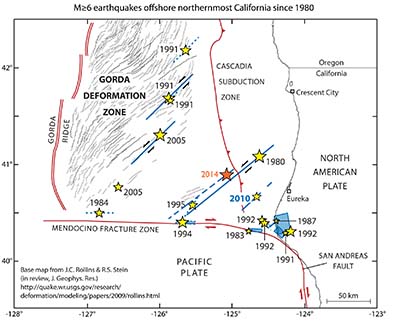Seismo Blog
Another Strong Earthquake Near Cape Mendocino
Categories: Mendocino Triple Junction
March 10, 2014

The epicenters of dozens of earthquakes with magnitudes greater than 6 dot this map of the tectonic situation near Cape Mendocino. The location of Sunday night's temblor is shown as an orange star. The earthquake labeled with a blue '2010' was described in a previous blog. (Map courtesy of Ross Stein, USGS) (Click to view larger image.)
Another strong earthquake occurred late Sunday night in the far northern regions of the State. The offshore magnitude 6.9 temblor was widely felt from Roseburg and Medford in southern Oregon all the way to the Bay Area and beyond. Although no significant damage was reported on land within the first several hours of the quake, residents in Humboldt County felt the shaking for dozens of seconds. The quake struck at 10:18 pm. Its hypocenter was almost exactly 50 miles west of Eureka on what is known as the Gorda Plate.
This small cousin of the Pacific Plate glides under the North American Plate in the Cascadia subduction zone. This very seismically active area reaches from Northern California all the way to the state of Washington. The boundary line between the Pacific Plate and the Gorda Plate west of Cape Mendocino is a fault similar to the San Andreas, variably called the Mendocino Transform Fault or the Mendocino Fracture Zone. It points from Cape Mendocino for several hundred miles straight west into the Pacific Ocean. Along this fault, the Gorda Plate slides horizontally to the east with respect to the Pacific Plate with a speed of about 2 inches per year.
Sunday night's quake was located just north of this fracture zone inside the Gorda Plate. This area has to absorb a lot of mechanical strain, which makes it one of the most seismically active regions in the state. Since 1980 there have been at least ten strong earthquakes with magnitudes of 6.5 and above, including the one which shook the region on Sunday night. Taking all of these larger earthquakes and the thousands of smaller ones together, the region around Cape Mendocino has a very clear distinction among seismologists. When measured by the release of seismic energy, it is in fact the most active region of California, beating by far the active faults of the Bay Area and the seismically notorious Los Angeles Basin and its surrounding mountains. (hra090)
BSL Blogging Team: Who we are
Recent Posts
-
: Alerts for the Whole West Coast
-
: Destruction in the Eastern Aegean Sea
-
: An Explosion in Beirut heard all over the Middle East
View Posts By Location
Categories
- Alaska (3)
- Bay Area (24)
- Buildings (3)
- Calaveras (4)
- California (13)
- California ShakeOut (3)
- Central California (4)
- Chile (4)
- Earthquake Early Warning (10)
- Earthquake Faults and Faulting (44)
- Earthquake Science (3)
- Haiti (3)
- Hayward (12)
- Indonesia (4)
- Induced Seismicity (3)
- Instrumentation (18)
- Italy (6)
- Japan (7)
- MOBB (3)
- Mendocino Triple Junction (5)
- Mexico (7)
- Nepal (3)
- North Korea (5)
- Nuclear Test (5)
- Ocean Bottom Seismometer (3)
- Oklahoma (4)
- Plate Tectonics (18)
- Preparedness, Risks, and Hazards (16)
- Salton Sea (3)
- San Andreas Fault (14)
- Seismic Waves (13)
- Seismograms (4)
- ShakeAlert (3)
- Southern California (5)
- Surface Waves (3)
- Today in Earthquake History (20)
- Volcanoes (4)
- subduction (3)